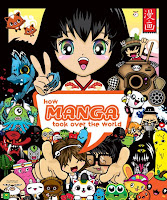In Japan, people of all ages read manga. The medium includes a broad range of subjects: action-adventure, romance, sports and games, historical drama, comedy, science fiction and fantasy, mystery, horror, sexuality, and business/commerce, among others.[4] Since the 1950s, manga have steadily become a major part of the Japanese publishing industry,[5] representing a 406 billion yen market in Japan in 2007 (approximately $3.6 billion). Manga have also become increasingly[vague] popular worldwide.[6] In 2008, the U.S. and Canadian manga market was $175 million. Manga are typically printed in black-and-white,[7] although some full-color manga exist (e.g. Colorful). In Japan, manga are usually serialized in telephone book-size[vague] manga magazines, often containing many stories, each presented in a single episode to be continued in the next issue. If the series is successful, collected chapters may be republished in paperback books called tankōbon.[8] A manga artist (mangaka in Japanese) typically works with a few assistants in a small studio and is associated with a creative editor from a commercial publishing company.[2] If a manga series is popular enough, it may be animated after or even during its run,[9] although sometimes manga are drawn centering on previously existing live-action or animated films[10] (e.g. Star Wars).
"Manga" as a term used outside Japan refers specifically to comics originally published in Japan.[11] However, manga-influenced comics, among original works, exist in other parts of the world, particularly in Taiwan ("manhua"), South Korea ("manhwa"),[12] and the People's Republic of China, notably Hong Kong ("manhua").[13] In France, "la nouvelle manga" has developed as a form of bande dessinée (literally drawn strip) drawn in styles influenced by Japanese manga. In the United States, people refer to what they perceive as manga "styled" comics as Amerimanga, world manga, or original English-language manga (OEL manga). Still, the original term "manga" is primarily used in English-speaking countries solely to describe comics of Japanese origin.
History
Kanagaki Robun and Kawanabe Kyosai created the first manga magazine in 1874: Eshinbun Nipponchi. The magazine was heavily influenced by Japan Punch, founded in 1862 by Charles Wirgman, a British cartoonist. Eshinbun Nipponchi had a very simple style of drawings and did not become popular with many people. Eshinbun Nipponchi ended after three issues. The magazine Kisho Shimbun in 1875 was inspired by Eshinbun Nipponchi, which was followed by Marumaru Chinbun in 1877, and then Garakuta Chinpo in 1879.[45] Shōnen Sekai was the first shōnen magazine created in 1895 by Iwaya Sazanami, a famous writer of Japanese children's literature back then. Shōnen Sekai had a strong focus on the First Sino-Japanese War.[46]In 1905 the manga-magazine publishing boom started with the Russo-Japanese War,[47] Tokyo Pakku was created and became a huge hit.[48] After Tokyo Pakku in 1905, a female version of Shōnen Sekai was created and named Shōjo Sekai, considered the first shōjo magazine.[49] Shōnen Pakku was made and is considered the first kodomo magazine. The kodomo demographic was in an early stage of development in the Meiji period. Shōnen Pakku was influenced from foreign children's magazines such as Puck which an employee of Jitsugyō no Nihon (publisher of the magazine) saw and decided to emulate. In 1924, Kodomo Pakku was launched as another kodomo magazine after Shōnen Pakku.[48] During the boom, Poten (derived from the French "potin") was published in 1908. All the pages were in full color with influences from Tokyo Pakku and Osaka Pakku. It is unknown if there were any more issues besides the first one.[47] Kodomo Pakku was launched May 1924 by Tokyosha and featured high-quality art by many members of the manga artistry like Takei Takeo, Takehisa Yumeji and Aso Yutaka. Some of the manga featured speech balloons, where other manga from the previous eras did not use speech balloons and were silent.[48]
Published from May 1935 to January 1941, Manga no Kuni coincided with the period of the Second Sino-Japanese War. Manga no Kuni featured information on becoming a mangaka and on other comics industries around the world. Manga no Kuni handed its title to Sashie Manga Kenkyū in August 1940.[50]
info taken from www.wikipedia.org


